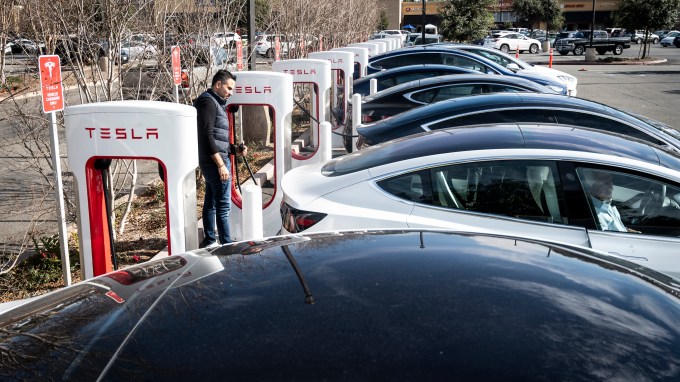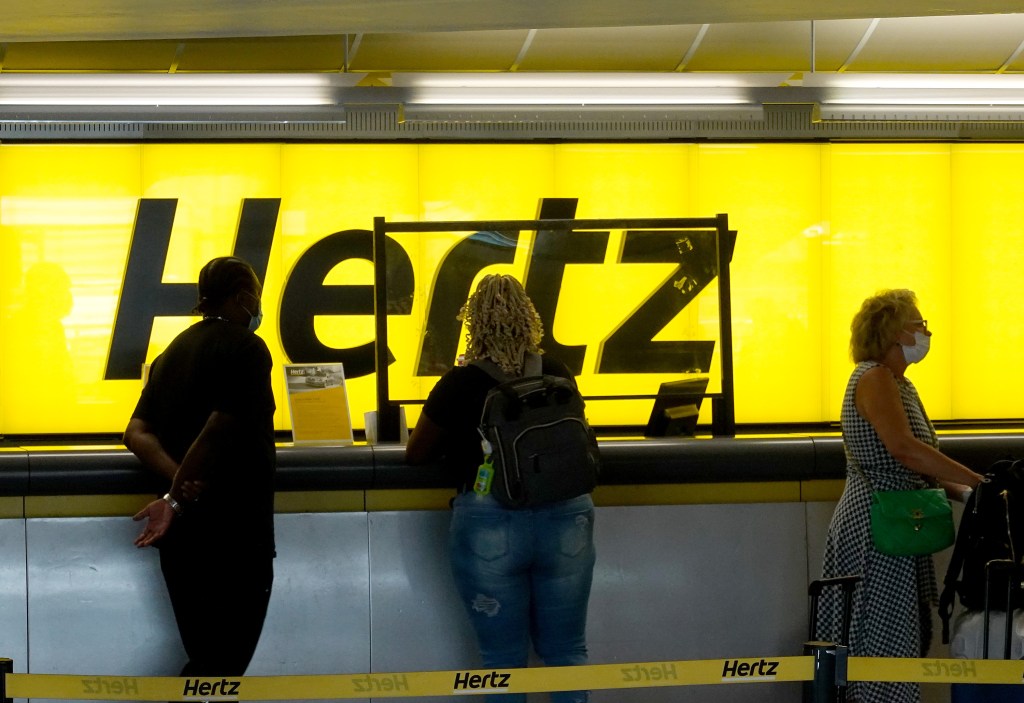Hertz made a splash in 2021 when it announced that it would buy 100,000 Tesla Model 3 sedans in a little over a year. Six months later, the rental car company said it would buy 65,000 Polestars over five years. It appeared that the EV transition was about to sweep the rental car market.
On Thursday, the sweep sputtered.
Hertz said in an SEC filing that it would be selling 20,000 of its EVs and replacing them with fossil fuel–powered vehicles. Another sign of EV momentum slowing? Perhaps. But it’s more likely a precautionary tale for how businesses should assess new markets — and how not to introduce a new product to your customers.
After Hertz started buying EVs, it directed most of them to Uber drivers. Uber was pushing drivers toward EVs in a number of markets, cities like New York were enticing them to make the switch, and they had attractive operating costs relative to gas-powered cars. Uber drivers also rented the cars for longer periods of time, Hertz said, meaning that fewer employees were needed to support a given number of vehicles. Plus, maintenance costs were lower, and Hertz was able to rent them at higher prices.
“Electric vehicles open the door to our growing presence in ride-share, where electrification is a fast approaching requirement not merely an option, in a channel where we are uniquely positioned,” Hertz CEO Stephen Scherr said in the company’s Q3 earnings call.
But while maintenance costs may have been lower, repairing damage from collisions ended up being higher than expected. Given that Teslas cost more to repair, that shouldn’t come as a surprise. They’re relatively new vehicles, and body shops don’t have as much experience with them. It’s a problem that’s not unique to Teslas: Fixing a Volkswagen costs more than fixing a Chevy, for example. Why Hertz thought its cars would be different is anyone’s guess.
High-damage repair costs were compounded by the fact that many of the ride-share drivers Hertz rented to were either inexperienced or bad drivers or both. Hertz had “higher incidents of damage among EV ride-share drivers,” Scherr said, forcing the company to “re-underwrite the ride-share driver base.”
In other words, Hertz had to restrict which ride-share drivers could rent EVs because the bad ones were wrecking them too frequently, racking up expensive repair bills.
As a result, Scherr added, “this left leisure over-fleeted with EVs.” Translation: The EVs that couldn’t be rented to ride-share drivers were pushed onto vacationers. The company’s initial mix, aimed primarily at ride-share, where there was demand, was shifted toward leisure drivers, who had expressed some but not nearly as much interest. The problems occurred when Hertz made the change without substantially changing its EV rental experience.
The good and the bad
I had two encounters with Hertz EVs in the past year and a half. One was pretty good, the other not, and it was the second one that suggested the rental car company wasn’t up to the task.
My first Hertz EV experience was with a Tesla, the only car available at O’Hare when I booked. That experience went well. The company directed me to the counter, where an employee gave me a quick tutorial on driving and charging a Model 3. I was offered the chance to deposit $35 in case I wasn’t able to charge the car to 70% upon return, but thanks to the Level 1 (120v) charger in the frunk and Tesla’s widespread Supercharger network, I got my money back.
My second experience was looking so dire that I aborted before even loading my bags. I hadn’t selected an EV, but instead was given a choice of vehicles from a particular row. One was a Polestar 2, a car I had been eager to drive. But after finding nearby fast-charging options lacking and the car’s Level 1 charger missing, I gave up. I’ve owned one EV or another since 2015; I know that without any way to conveniently charge, the car would be more hassle than it was worth.
Now imagine how that situation would play out for someone who has never driven an EV.

Actually, we don’t have to imagine. Plenty of people have posted online about their experiences, and while some are glowing, many reflect the frustration of customers forced to use a product that the company hasn’t fully thought through.
One person posted on Reddit that they rented from a Hertz location in Manhattan that only had EVs. They had never driven an EV and didn’t agree to rent one. But it being Thanksgiving weekend, they had places to be, so took a Kia EV6 anyway. They attempted to charge at a Tesla Supercharger, at which point they discovered the car wasn’t compatible with the plug. Then they had a very typical encounter at their hotel where the Level 2 charger wasn’t working. Finally, they had to scour Manhattan to find a place to charge before returning the car.
Even experienced EV owners have found Hertz’s EV rentals frustrating. “Rental car companies need to include the L1 charger. Rental car companies need to have cars start at 80%,” Reddit user kadoro said of their Hertz experience. The first car they considered only had 40% charge, the second one had 49%, and the third one, which they picked, had 51%. Imagine renting a gas car with half a tank. People would be livid! Also, because kadoro didn’t have access to an app, they said trip planning was much harder than with their personal Nissan Leaf or Chevy Bolt.
Simple fixes
All of these are problems that could be fixed with some thoughtful planning on Hertz’s part. Here’s a brief (though not comprehensive) list of what rental car companies need to do if they are to make EVs work for their fleets:
- Make sure working Level 1 chargers are included in every vehicle.
- Include a map of compatible charging locations either on the company’s website or app (preferably both).
- Deliver vehicles to customers with 100% state of charge.
- Upon delivery, inform the customer where the nearest compatible fast-charging location is.
- If fast-charging stations are absent or unreliable, the rental car company should install and maintain its own for customers to use at market rates.
- If it chooses not to install and maintain its own chargers for customers to use, then it should offer employee-managed charging at a reasonable cost.
That’s a pretty basic list, and something that’s well within Hertz’s (and other rental companies’) powers to fix.
Indeed, Hertz basically said as much. In its SEC filing, it all but admitted that it botched the rollout. The company said that it is trying to improve EV rental profitability by expanding EV charging infrastructure, securing more affordable repair parts and labor, and “continued implementation of policies and educational tools to help enhance the EV experience for customers.” That’s corporate-speak for “we weren’t ready.”
The timing of Hertz’s EV liquidation is perhaps surprising, but then again, most rental cars are sold after a couple years of service. It was going to happen eventually. The only reason this is news is that Hertz had to file an 8-K because of the $245 million charge it has to book. And that charge happened largely because its Teslas depreciated faster than expected after the price cuts. The reason it’s selling them now is because it shifted the cars to leisure customers before it was adequately prepared to support them.
The short of it is that Hertz did a bad job underwriting its ride-share customers, and it bought its EVs at the peak of the market. It’s true that many customers aren’t ready for EVs, but it’s also true that Hertz wasn’t ready to rent to them, either.































Comment